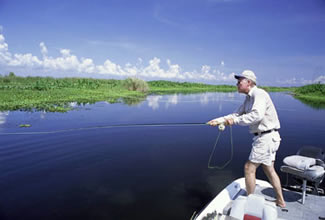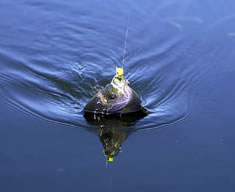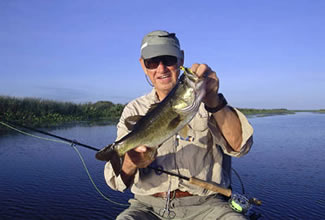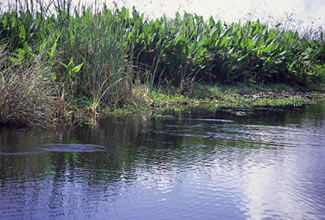June 10, 2015
By Terry Gibson
Classic summer Okeechobee bass-bugging at its best.

A perfect, windles day for fly fishing with 6-weights and small poppers. Bert Gibson throws a tight loop.
|
By early June last year, Lake Okeechobee was low, 11 feet, three inches, so low bass and panfish were jammed into natural depressions and manmade canals around Belle Glade.
“The schoolies are thick,” said Capt. Pete Moore, “and you're guaranteed to take home a mess of big, copper-nosed bluegills.”
Pete, one of the few Lake O guides who primarily fly fishes, has been on the lake since the late '60s, and has devoted decades' worth of springs to bass bugging. Before rising water temps become suffocating, a bass bugger, if he finds the right ditch, can outfish his hardware-chunking brethren a dozen fish to one. Plus, bring home a mess of panfish fillets.
Throughout summer, the Everglades teems with insect hatches, and the hungry, competitive fish keep one eye on the surface, at least during the cooler hours of the day. So, early in June, Pete carried us out to the old irrigation ditches that snake through Kramer Island and Ritta Island, the very canals where my dad learned to fly fish as a kid, and where he taught me when I was a young boy. Pete has worked hard to prevent a dubious sheet-flow restoration project from backfilling most of these canals (see sidebar), and wanting my first visit to the place in many years to be memorable, he reserved a day for us right before the full moon.
The water at Pelican Bay was so low Pete had to make the tight turns into the canals without coming off of plane. He didn't mind—low water keeps all but the most determined anglers out, it helps encourage important aquatic and subaquatic grasses, and it concentrates fish in the canals. Plus, a wild streak runs through old Pete; when he gets behind the wheel of his bass boat, he grins as gleefully as a kid revving his hotrod. But, as the bass boat settled into the tepid water, smoky wisps of fog glowed red around the running lights, and the glittery vessel—all gadgets and sharp lines—seemed a time machine touching down on “big waters.”
That's the effect, anyway, that fishing and hunting on Lake Okeechobee often has on me, especially when fishing or hunting with folks who've long known the lake. On that foggy morning, the long, gnarled fingers of history tapped me firmly on the shoulder.
As Dad and Pete reached for 6-weight rods they were as anxious and enthusiastic as boys. The verdant marsh and soft morning light made them look much younger, and I could easily picture my father as a teenager fly fishing from the pram he rowed out from Torry Island, as well as Pete making his first tentative explorations of the lake in an old johnboat. I could also picture the Stein boys rebuilding the levees after the '47 hurricane, then again after the storm in '49, when the family farmed Kramer Island.

June is a prime month for big bluegills.
|
“The storms washed the levees into the canals,” Fritz Stein Jr. told me, “so Dad sent me on dynamite runs to Miami. They also washed out the twin bridges, so we ferried work crews out in a barge. We bought an Army surplus crane, and used a dragline to move the barge one toss of the bucket at a time. The bucket left ‘dinosaur tracks' in the lake bottom—shellcrackers still love to bed in them.”
When he got a break from farming, Stein also loved to ply the banks with poppers. He'll tell you that those canals, which ran with the blood, sweat and pathos of Glades' pioneers, have always attracted birds, bass and panfish. Now, the marsh has reclaimed fields, and the area is a natural historical irony. The old fields became prime habitat for dabbling ducks, wading birds and forage fish, and when lake levels are falling, little rivulets drain them into the canals. Then, the entire food chain lines up at the mouths of those drainages in ascending order.
A gator lurked at the mouth of one of those rivulets.
“When the gators are up like that,” Pete said, “they're feeding on bass.”

Capt. Pete Moore holds a larger schoolie bass. The fish struck after a downward rod stroke.
|
Webbed feet under its shoulders and haunches, and tail angled low in the water like an idling outboard, the 6-footer lay poised at the mouth of the run. Sure enough, a fish swirled in the hole, and with a tail flick the reptile sprang across the hydrilla like an overgrown Jesus lizard, then plunged its jaws into the black water. The snout raised triumphantly, the jaws crunched, the white throat opened, and the little bass became natural history.
“He needs to chew his food more,” Pete quipped, “or he'll give himself gas.”
We took the cue and cast our No. 4 chartreuse poppers into those spots. But up and down the canal, the staccato explosions of schoolie bass made it difficult to ward off the temptation to make constant, reactionary presentations. Evidently, the fish were keyed in on a hatch of invisible insects, chisiwinks perhaps, so I eyed the popper skeptically before casting it.
“Twitch it into the hole,” Pete counseled, “let it sit a while, and pop it with a hard downward stroke of the rod.” I popped the bug, and the echoing rings hadn't radiated out to the edge of the hole before a 2-pound bass exploded on my bug.
During these months, Pete almost exclusively targets bass with the cork poppers he buys from the folks who made Uncle Bob's poppers. These fish take big deerhair bugs, as well, and yes, bigger flies catch bigger fish. But, most summertime bass run one to four pounds; further, the big bluegills can't wrap their mouths around a big wad of deerhair.
Pete has also experimented with closed-cell foam poppers, but even the smaller foam bugs land with the grace of a drowned muskrat. And although they make great big poppers, small foam bugs often ride too low in the water, and hence fail to make that satisfying, confidence-inspiring bullfroggish gurgle that cork makes.
“The whole idea behind a popper is to make a fly small enough to cast but that lo
oks like a mouthful to a bass,” Pete said. “The high-floating cork bugs with cupped faces also make the popper sound like more of a mouthful. You can tempt a big fish with a smaller cork popper. I like sizes 4 through 8, which will also spare you ‘9-weight elbow.' Just don't go so small that the tiny panfish suck them down first.”
Pete paints his poppers with yellow, red-rimmed faces and chartreuse bodies. He also favors a chartreuse bug with green scales painted all around it. He wraps white rubber legs along the hook shank, so they splay out to the side. Then he attaches a short marabou tail. If you wrap under the back of the marabou, lifting it slightly, you reduce the frequency with which the tail fouls around the hook bend.

A bass blitz on tiny insects. They would not take a wet fly.
|
Pete's popper philosophy departs from my own when it comes to weedguards.
“I only use weedguards around lily pads, they cost you too many fish,” Pete says, insistently. He has a point. Every few trips, a slob sucks down one of his creations, and he'd rather not risk any chance at missing a big fish. But, I'm willing to assume the risk, especially around hydrilla. Cork is soft enough you can easily bore a hole with a big needle in the cork. Glue a single strand of 20-pound Mason hard mono, or 15-pound on smaller bugs, that extends slightly past the hook point. The mono works like a vaulting pole to make the bug leap off the matted vegetation; it keeps the bug clean and in the water, which leads to more strikes.
Bass either strike poppers viciously, or they suck them down almost imperceptibly. If you want to learn how to set the hook while fly fishing for bass with popping bugs, pay a visit to the aquarium at Slim's Fish Camp on Torry Island around feeding time. They don't chase a shiner down, they breathe it in. You can see the scales squirt out of the gills. So, lifting the rodtip is the absolute worst response to either strike; usually the bug just flies back out the wide opening on a dangerous trajectory. Strip strike, and wait until you feel tension in your line hand before lifting the rod.
Bass bugs give a little, especially cork bugs; they have a texture similar to an insect's exoskeleton or the skull of a small frog, so there's no hurry. The fish will usually hang onto the bug for a couple of seconds—more than enough time to feel the fish and set the hook. And once you're on, keep the rodtip low, and bent 180 degrees away from the direction in which the fish lunges. If you're fishing with at least 12-pound tippet, and you keep the rod angled properly, you can turn a big bass away from cover with a 6-weight rod.
We got plenty of practice that morning. We even found a school of bass blitzing like a horde of stripers. Despite the frenetic bite, the fish wouldn't take a swift-moving bug—we fished them dead still. I even tried a couple of small baitfish and Woolly Bugger patterns, and caught but one fish to every five bucketmouths that Dad and Pete each landed, which proved again that there's no more classic, entertaining, or productive dry-season, early morning, warm-weather bass fishing technique than plying the ditches with a chartreuse cork popper.
FS
